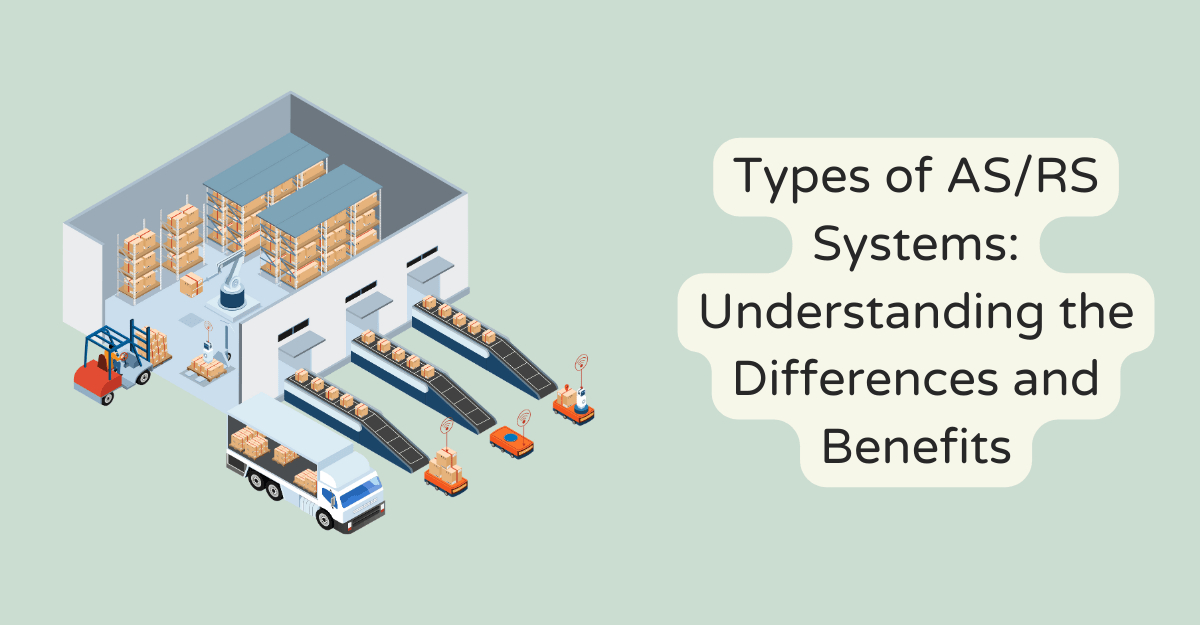
Types of AS/RS Systems: Understanding the Differences and Benefits
Efficiency, accuracy, and space optimization are paramount in the world of logistics and warehousing. Automated storage and retrieval systems (AS/RS) have emerged as pivotal solutions in this regard, revolutionizing how businesses store, retrieve, and manage their inventories.
These sophisticated systems combine high-density storage, precision, and automation, boosting operational workflows.
In this post, we delve into the essence of AS/RS systems, exploring the different types available, determining the best fit for various business needs, and highlighting the many benefits they bring to the table.
What Are Automated Storage and Retrieval Systems?
AS/RS systems are integral to any modern warehouse or distribution center, designed to handle storing and retrieving products with unmatched speed and precision.
At its core, an AS/RS system consists of high-density storage racks, automated cranes or robotic shuttles, and sophisticated software in charge of managing the logistics.
The principle behind these systems is as straightforward as it is ingenious. Upon receiving an input, whether for retrieving or storing an item, the software calculates the most efficient way to execute said command.
An automated crane or shuttle robot then moves along the racks, guided by laser or RFID technology, placing or picking up the item from its designated location.
This automated process minimizes human error, enhances safety, and significantly reduces the time it takes to store or retrieve an item. Coupled with a warehouse management system (WMS), it enables businesses to maintain accurate stock levels and optimize their storage space.
Different Types of AS/RS Systems
The versatility of automated storage and retrieval systems is reflected in their various types, each designed to meet a specific operational demand. Let’s briefly explore the most prominent AS/RS system types and their unique applications:
- Unit-load — Ideal for handling large, heavy loads, such as pallets or large containers. These systems typically operate in narrow aisles, utilizing high-reach cranes to maximize vertical storage space.
- Mini-load — Tailored for smaller items, such as cases or totes. Unlike their heftier siblings described above, mini-load systems offer agility and precision. They employ smaller, faster cranes or robotic arms to access shelves or bins and are often used where there’s a need for quick access to a variety of SKUs.
- Robotic shuttle-based — Highly scalable and flexible. These systems use autonomous robots moving along tracks at various levels, allowing for easy reconfiguration and expansion. These systems are suited for environments with a wide range of product types and sizes.
- Horizontal carousel — Ideal for high-speed picking. They reduce travel time by moving goods to the operator through rotating shelves and are often used in conjunction with pick-to-light systems.
Determining the Best AS/RS System for Your Business
This section outlines the key considerations for selecting the AS/RS system that best suits your specific needs. Here are a few factors to keep in mind:
- Inventory type and volume — Assess the kinds of items you’re storing (e.g., pallets, cases, individual items, etc.) and their sizes, weights, and turnover rates.
- Warehouse space — Evaluate your available space, including ceiling height and floor area. Vertical lift modules or high-bay warehouses may help maximize your vertical space.
- Operational flexibility — Consider future growth or changes in product lines. As mentioned, robotic shuttle-based systems offer scalability and flexibility to adapt to changing business needs.
- Throughput requirements — Determine your required speed for storing and retrieving items.
- Integration with existing systems — Ensure that your chosen AS/RS can integrate seamlessly with your warehouse management system and other logistics software you may have implemented.
- Budget and ROI — While initial costs may appear significant, consider the long-term savings and efficiency gains. Analyze the potential return on investment based on improved productivity, space utilization, and reduced labor costs.
- Vendor support and maintenance — Choose a vendor with reliable customer service and maintenance support to ensure minimal downtime.
Key Benefits of Implementing AS/RS
Adopting an AS/RS can be a transformative step for any warehouse or distribution center, driving efficiency and offering a competitive advantage. Let’s highlight a few benefits that underscore this potential value:
- Enhanced efficiency and productivity — Most notably, AS/RS systems streamline the storage and retrieval process, significantly reducing the time it takes to move items in and out of storage. This automation allows for continuous operation, minimizing delays and maximizing output.
- Improved space utilization — Reducing aisle widths and optimizing vertical space enables warehouses to increase their storage capacity within the same footprint.
- Increased accuracy and reduced error rates — Automation reduces the risk of human error in picking and placing items, leading to higher accuracy in order fulfillment and inventory management in general.
- Reduced labor costs — Automating repetitive tasks reduces the need for human labor, allowing your staff to spend their time on more value-added activities. The enhanced worker safety that comes from minimizing their exposure to potentially hazardous environments is also worth mentioning.
- Scalability and flexibility — Modern AS/RS solutions offer scalability to grow with your business. Depending on the type, they can be quite easy to expand and reconfigure to accommodate new products, fluctuating demand, or operational changes.
- Enhanced inventory control — With real-time tracking and inventory management, AS/RS systems ensure accurate stock levels, reducing overstock and stockouts.
Final Thoughts
Implementing an automated storage and retrieval system could represent a significant investment in your company’s future, promising to improve current operations and position your warehouse or distribution center for scalable, long-term growth.
We hope this post has illuminated the path toward optimizing your warehouse operations and sparked interest in the transformative potential of AS/RS. Good luck with your endeavors in harnessing the benefits of automation for a more efficient, accurate, and productive warehouse.






